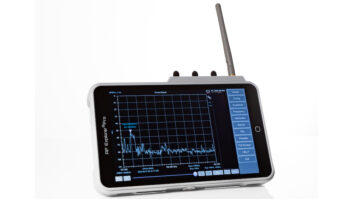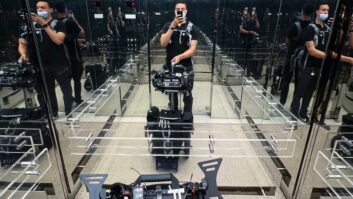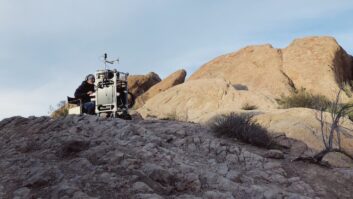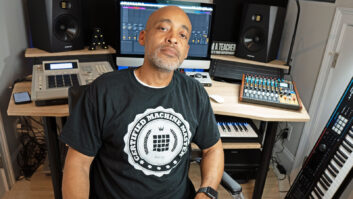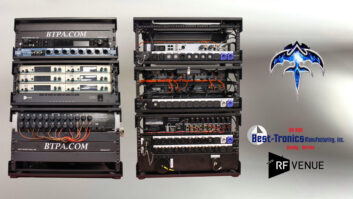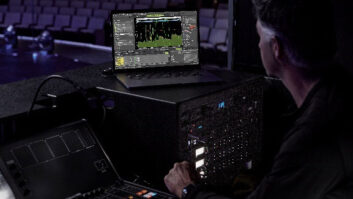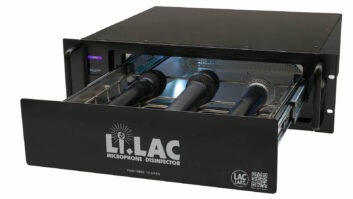For years, certainly since the transition to DTV in 2010, when wireless audio equipment operators had to vacate the 700 MHz band, RF coordinators have been warning that the sky is falling. Well, that day is here.
In the Federal Communications Commission’s Incentive Auction, which ended on April 13, 2017, major telecom companies won access to much of the 600 MHz band. The initial auction rules suggested that wireless mic users might have up to three years to move out of the spectrum. But on July 19, the biggest licensee of 600 MHz spectrum, T-Mobile, announced its intention to light up new services beginning in August in “at least 10 MHz of 600 MHz spectrum covering 1.2 million square miles.” Microsoft, too, is pressing the FCC for 600 MHz spectrum for its rural broadband initiative.
Loss of the 600 MHz band is going to make wireless coordinators’ jobs that much more difficult, especially for those working large, multistage music festivals or other similarly large events. The challenge is not just how to squeeze more channels into less bandwidth, however.
Any director, producer and production manager organizing a music festival knows that they are going to have to hire an audio company, a lighting company, a video company and a backline company, says Danny Lane, RF project manager, Professional Wireless Systems (PWS). “The reality now is that you have to hire an RF company, too.”
Lane has been sounding the alarm with his clients about the imminent loss of spectrum for some time. “The last couple of years have been difficult because I’ve been talking to people who don’t understand what I’m telling them, and then I’m asking them for tens of thousands of dollars. They’re asking me why they’ve never needed it before; I’m trying to warn them. The analogy I use is, I’m standing on the dock the day the Titanic sailed trying to sell life-preservers, and nobody is buying because the Titanic is unsinkable,” he laughs.
With T-Mobile’s August kickoff, the fall festivals could find themselves the first to be impacted, says Lane: “Outside Lands and Treasure Islands in San Francisco and Kaboo in San Diego could get hammered.”
One solution would be to hire a great wireless coordinator. “But there are only so many really good RF coordinators in this country, and look at how many large events happen in a year,” he says.
Wrangling RF at a major music festival requires a great deal of planning and coordination. At Coachella, which is held for two consecutive weekends in the Southern California desert east of Los Angeles, PWS typically handles just over 400 channels for the artists and production crews. This year, Lady Gaga requested 56 frequencies and Hans Zimmer requested 48 frequencies.
PWS must design a frequency coordination plan that allows artists to perform simultaneously on seven stages without interfering with each other’s microphones and in-ears or the production comms. It’s easy to forget, if you receive television via cable or satellite, that stations continue to transmit over the air, adding to the potential conflicts. “We found 16 DTV channels at Coachella—and an analog channel, which was kind of crazy,” says Lane.
Before Lane arrives at a corporate event, awards show or sports event, he has all the information he needs to coordinate the RF. In contrast, “On festivals, I’m a few days out and I have maybe a tenth of what I need,” he reports.
Several years ago, one artist turned up with a one-watt transmitter (for comparison, RF mic systems by Sennheiser, Shure and others are typically no more than 250 mW). During soundcheck, Lane sent a tech to the festival’s farthest stage with an analyzer. “He could see it coming through loud and clear. We had to go back to our trailer and re-coordinate the entire day of that show.”
“Once T-Mobile begins to energize and takes out about half the performances—because half of the mics out there are above 600 MHz—by a couple of big name acts, then maybe we’ll start to see the attention from producers to get a budget to get a coordinator on-site,” predicts James Stoffo. Across more than three decades, Stoffo, who founded PWS in 1992 and sold it to Masque Sound in 2001, has earned a reputation as one of a handful of RF gurus in this country.
But until now, promoters and producers have been unwilling to budget for the extra cost. “You need spectrum analyzers and some pretty expensive equipment, so it doesn’t come cheap,” comments Stoffo.
“And the more complicated it gets, the more guys I need to do it correctly,” adds Lane, “which means the cost goes up—flights, hotels, per diems. It’s no longer viable with two guys. Instead of a show that may cost $15,000 to do this year, in two years, it may cost $30,000.”
That said, Lane will handle three stages plus another performance area at Panorama on New York’s Randall’s Island at the end of July with one other crew member—and a bicycle. “I don’t even have a golf cart; it’s going to get crazy,” he says.
“The problem I’m running into with Panorama is that there’s a large chunk of spectrum that is unusable, from 566 to 638 MHz. We’re trying to wrangle our way around it. I have 60 bands coming in and four different sound companies, and there are ENG crews and everything else happening.”
Advance information suggests that many of Panorama’s artists have equipment that operates in those unusable frequencies, Lane reports. “If you bring something, there’s no point even turning it on,” he cautions. “You can use festival RF that’s already coordinated, from one of the audio companies providing per stage, or you’ll have to rent.”
What strategies can audio equipment RF coordinators employ in this new environment, which has shrunk by 192 MHz since 2010? Stoffo, who says that he has already done his last show using 600 MHz equipment, says, “In-ears are nice, but if you have to lose something, it seems like you already have wedges out there. That’ll free up half-a-dozen to a dozen frequencies. On a larger show like the Grammys, it could be two-dozen frequencies.” It remains to be seen if there will be pushback from artists concerned about their hearing, however.
Beyond that, he suggests, “You’re going to have to have background vocalists on wires. There’s no need to have a wireless mic on a stand that doesn’t move.”
“There was an artist at Coachella this year whose band played behind the stage,” says Lane. “They weren’t even in view of the audience, yet some of them were wireless. We made it work, but stuff like that has got to go away.”
Stoffo’s new venture is Radio Active Designs (RAD), an analog, VHF intercom system that packs many channels into relatively little bandwidth. VHF gear, unlike Part 15 unlicensed products operating in spectrum above the TV bands, offers the advantage that it can be coordinated, he also notes. “Nobody owns 902 to 928 MHz, or the 1.9 GHz and 2.4 GHz bands. Those airwaves are unlicensed; that means if you get interfered with, you have nowhere to go to troubleshoot, and you have no rights or priority in those bands.”
Stoffo has long since pulled his intercoms out of UHF at shows such as the Country Music Association Awards, where typically 100 of the 250 wireless channels are comms. “We’ve been using Telex and HME, which are above 600 MHz. Now you also have Clear-Com, RAD, Telex, Riedel and CoachComm out of the traditional UHF spectrum. That doubles the number of frequencies you can use for UHF microphones.”
Adopting distributed antenna systems is another option. And instead of running hundreds, if not thousands, of pounds of copper cable, says Stoffo, “You’re going to see people run a couple of strands of fiber. We like the Zinwave system, which is a pretty high-end fiber system that covers VHF all the way up through the high-band [1.9 GHz/2.4 GHz] FreeSpeak stuff.”
Antenna farms would enable multiple stages to operate simultaneously without interfering with each other, says Lane. “But there’s seven stages at Coachella, and I’d need a bunch of cable, a load-in day, three guys—the price keeps going up.”
The bottom line for sound companies and any other entities that qualify is to get a license, says Lane. “I can’t believe there aren’t any major sound companies that haven’t gone to Part 74. But if they haven’t yet, then they’re not preparing for this.”
That goes for their wireless equipment inventory, too, he says. For the past couple of years, Lane has been advising production providers to sell off their affected RF gear to areas of the world where 600 MHz is still accessible. Otherwise, he says, “There’s a ton of gear that’s going to end up being paperweights.”
